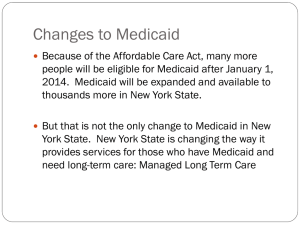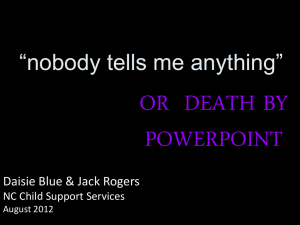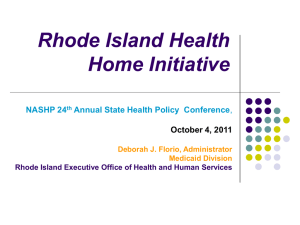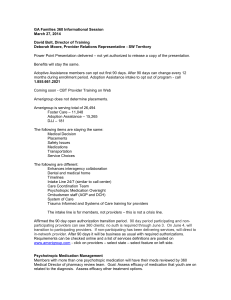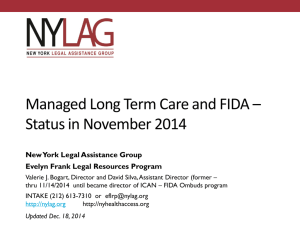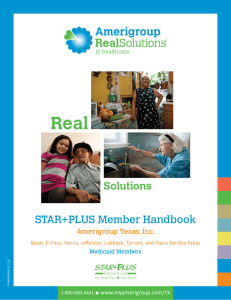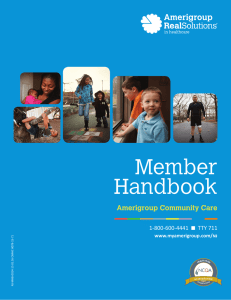Robert Wychulis, CEO of Amerigroup New York
advertisement
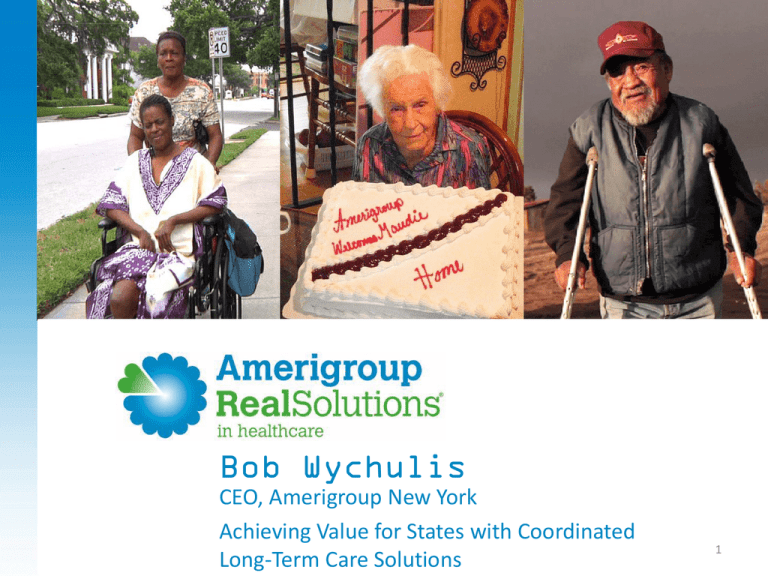
Bob Wychulis CEO, Amerigroup New York Achieving Value for States with Coordinated Long-Term Care Solutions 1 Overview • • • • About Amerigroup New York Medicaid Redesign Solutions State Models of Managed Long-Term Care (MLTC) Medicaid Health Plans and MLTC 2 Who We Are: Amerigroup • We coordinate health care services for 2 million members in 11 states, including New York • We meet the health care needs of financially vulnerable Americans, seniors and people with disabilities • We serve those on Medicaid, Medicare and other publicly funded health care programs • We build strong community relationships and alliances to support our local health plans • We offer 15 years experience dedicated to government programs 3 Benefits of Medicaid Public-Private Partnerships As a Medicaid managed care organization we: 1. Increase access to care Managed care increases access to primary care and the use of preventive services while lowering costs 2. Yield cost savings By collaborating with doctors, hospitals and other providers to ensure beneficiaries receive proactive health services and supports, managed care reduces the incidence of acute episodes of care, improves the quality of life and reduces overall burden on the taxpayers 3. Achieve quality improvements Managed care achieves quality improvements by adhering to quality standards and monitoring procedures. No comparable standards or procedures are required in Fee-For-Service arrangements 4 Amerigroup in New York • Amerigroup New York serves 109,000 members in the Medicaid, Children’s Health Insurance Program (CHIP), MLTC and Medicare Advantage programs • Serves members in Putnam County and the five boroughs of New York City • We employ 380 associates, including 49 doctors, nurses and social workers • Network includes 16,375 providers and 48 hospitals • Fully integrated long-term care plan offering for dually eligible individuals 5 Looking Forward: Medicaid Redesign in New York • Focus of New York Medicaid Redesign Team (MRT): o o o o New York’s Medicaid program is unsustainable Need to build on managed care’s significant quality gains Goal: Develop a reform package that saves money and improves quality Identify major savings opportunities, including managed long-term care • New York Medicaid status quo: o 66 percent of recipients enrolled in a managed care model at a total cost of $17 billion; 27 percent are excluded from managed care at nearly double the cost – $29 billion o 11 percent of long-term care recipients are enrolled in MLTC, at a cost of slightly more than $1 billion o 89 percent receive LTC through an alternative model of care or an institution, at a total cost of more than $11 billion Source: State of New York Department of Health, New York Medicaid Redesign Team, “Building a more affordable, cost-effective Medicaid program” (Jan. 13, 2011) 6 State of Spending: High-Cost Patients 865,000 New York Medicaid Patients with Multiple Chronic Illness Intellectual or Development Disability Long-Term Care 50,000 recipients $6 billion/$10,500 Per Member, Per Month (PMPM) Issue: Rapidly growing expense 200,000 recipients $11 billion/$4,500 PMPM Issue: High cost – lack of services management and coordination Behavioral Health Chronic Medical 300,000 recipients $5 billion/$1,400 PMPM Issue: High cost – lack of services management and coordination 300,000 recipients $21 billion/$695 PMPM Issue: High cost – lack of services management and coordination Source: State of New York Department of Health, New York Medicaid Redesign Team, “Building a more affordable, cost-effective Medicaid program” (Jan. 13, 2011) 7 New York MRT Recommends Focused Approach to Long-Term Care Percent Change Per Recipient of Long-Term Care Spending, 2003–2009 (in New York, by Program, Six-Year Average) 89.5% New Solutions for Long-Term Care: • • • Managed Long-Term Care Consumer Directed Models Integration of Medicaid and Medicare 37.5% 38.3% 15.6% 23.6% 0.3% MLTC Nursing Adult Homes Day Care Source: State of New York Department of Health, New York Medicaid Redesign Team, “Working together to build a more affordable, costeffective Medicaid program: (Feb. 9, 2011) Long-Term Personal Certified Home Home Care Health Care Health Care Agencies 8 Tennessee and New Mexico: Other Successful MLTC Models Other models of managed long-term care help states increase quality of care while lowering costs TennCare CHOICES in Long-Term Care Program • 4,000 face-to-face assessments completed within first six months • Lowered nursing facility rate from 81 to 71 percent of membership Coordination of Long-Term Services (CoLTS) Program • 16,282 members enrolled into disease management programs • Cost of serving the CoLTS population in 2011 projected to save $25 million • 41 members transitioned from a nursing facility to a community-based setting, saving the State more than $1 million • Raised share of members in the community • 1,013 new services identified as “gaps in service” for members in home-based care • 207 members reintegrated from nursing facilities to the community • 2,345 healthy dual-eligible members at imminent risk of nursing facility placement have been kept out of nursing facilities 9 Developing Long-Term Care That Advocates Community Living • New York Managed Long-Term Care (MLTC) program enables members to maintain independence while receiving the care they need • Key program components include: o Applying a system of assessment, care planning and service coordination in order to restore or retain an individual’s level of function o Key services include: nursing services in the home, therapies in the home, home health aide services, personal care services in the home, adult day health care, social day care • By ensuring the right mix of services and supports, the Amerigroup program is able to: o Push-out the point at which an individual enters a nursing facility, or o Eliminate the need for institutionalization 10 Value of Managed Long-Term Care • Provides a one-source contact to help seniors and people with disabilities navigate the health care system • Transitions residents from institutional settings to their preferred setting: at home or in the community • Coordinates a system of care to identify additional service needs that prevent avoidable acute conditions • Offers caregivers and family members help supporting their loved ones • By preventing and avoiding institutionalization, improves member independence and quality of life 11 Real Stories, Real Results: “Rosa” • Amerigroup interventions improve the quality of life for New York MLTC recipients • About an Amerigroup member – “Rosa” o Diagnosed with degenerative scoliosis o Received Medicaid, Medicare Part D and a health plan benefits but was not receiving adequate care • Through Amerigroup, “Rosa” received supportive counseling and an assessment of her home environment and her functional status o She is able to keep her current home health aide, who was employed by a nonparticipating vendor o With Amerigroup, she is able to remain at home and maintain her independence 12 Real Stories, Real Results: “Sarah” • Amerigroup efforts enhance availability of services for New York MLTC recipients and their families • About an Amerigroup member – “Sarah” o Bedridden, diagnosed with aphasia and had limited mobility o Relied on her daughter for daily care and other services • Through Amerigroup, “Sarah” gains access to new equipment enhancing her quality of life and lessening the likelihood of hospitalization o She is able to access a proper hospital bed, pressure-reducing mattress and geriatric wheelchair to keep her healthy o With Amerigroup, she and her family accessed the services and equipment necessary to ensure Sarah remains at home with her family 13 Thank You Bob Wychulis Chief Executive Officer Amerigroup Community Care of New York 360 West 31st Street, Fifth Floor New York, NY 10001 (212) 372-6902 rwychul@amerigroupcorp.com www.amerigroupcorp.com 14


